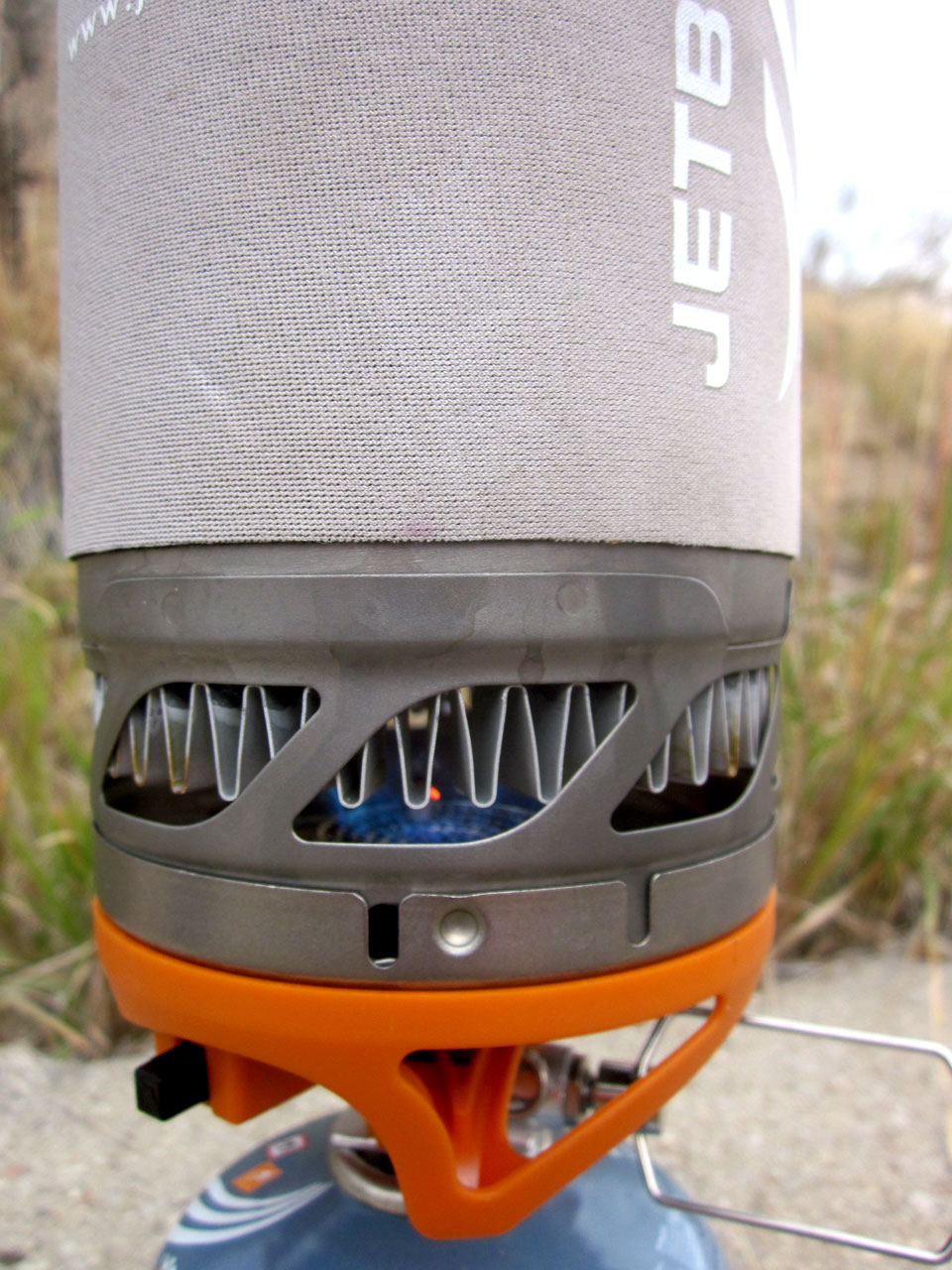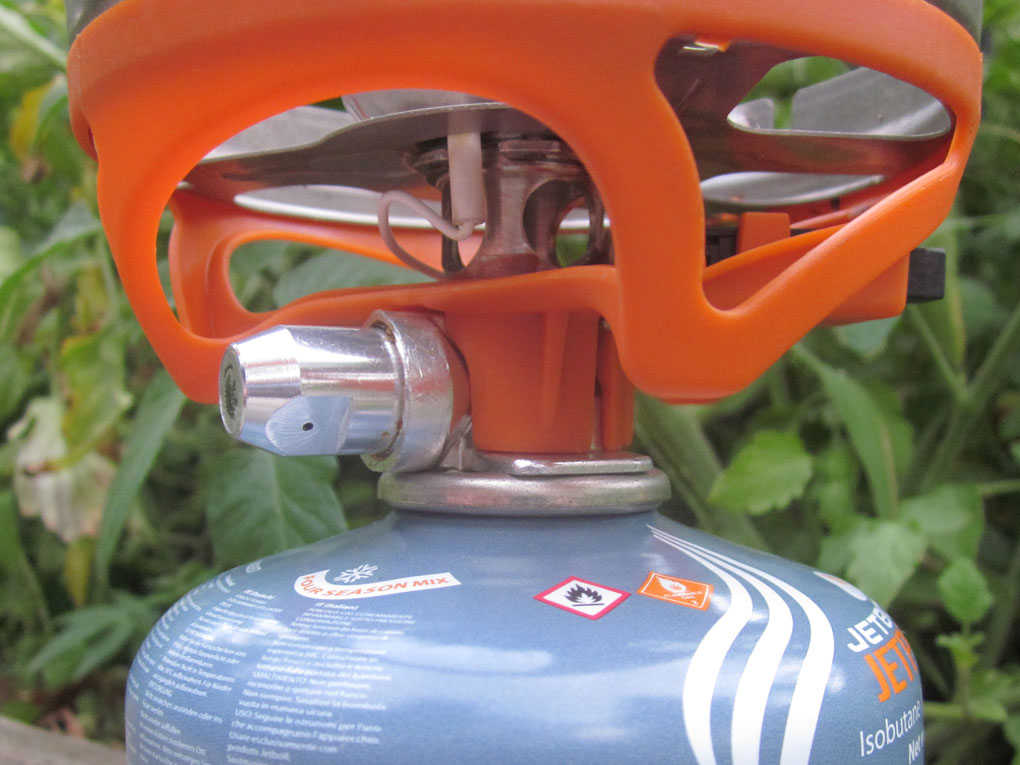Weight: 8.5 oz / 240 g (does not include pot support, fuel stabilizer and measuring cup)
Volume: 27 oz / 0.8 Liter
Boil Time: 16 oz / 0.5 Liter = 2 minutes, 15 seconds
Water Boiled: 12 Liters per 100g Jetpower canister
Dimensions: 4.1” x 6.5” / 104 mm x 165 mm
Features:
- Jetboil Thermo-Regulate™ technology – consistent heat down to 20˚ F (-6˚ C)
- 0.8 Liter Titanium FluxRing® cup
- Insulating Cozy
- Convenient, reliable push-button igniter
- Pot support and Stabilizer tripod included
- Drink-through lid with pour spout & strainer
- Bottom cover doubles as a bowl and measuring cup
- Compatible with all Jetboil accessories
MSRP: $150
Jetboil entered the camping-stove fray in 2001, taking canister cooking stoves and reinterpreting them as integrated systems. Since then they have become a prominent member of the gear world, adopted widely by backpackers.
After several iterations of their flagship stove, the Flash, Jetboil has branched out to include more versatility in their product line by introducing smaller, single-person units (the Sol) and larger options that are more group-friendly (Sumo, Helios). Most of these stoves have slightly lighter, titanium doppelgangers for those who are looking to shave off a couple more ounces.
It had been years since my last canister-based stove, so I was excited to try the Sol Ti, the smallest and lightest of the group, and see how far these stoves have come.
A word about the technical elements of the system before delving into field testing: the Sol Ti consists of three central components (the stove itself, the pot, and the fuel canister), as well as a couple of non-essential convenience parts (plastic stabilizing stand, metal stand to accommodate larger pots/pans).
Let’s start with the meat.
The Stove

The stove itself is a small disk about the size of a silver dollar, with a small ignition wire, all at the center of a ring of titanium. As the middle piece in the totem-pole-esque system, this entire unit screws onto the top of a fuel canister, while the upper titanium ring accepts the pot above it. The burner sits above the ignition button, the adjustable fuel flow-rate wire handle, and a protrusion that Jetboil refers to as the “thermo-regulate mechanism,” which is apparently Jetboil’s answer to the problem of decreasing pressure in the fuel canister over the course of a canister’s lifetime.
Here’s the essence of the problem: the contents of the fuel canister are under pressure to begin with, and the stoves rely on this internal pressure to expel fuel when the stove is burning. As fuel is consumed, the pressure inside the canister decreases, which in turn decreases the rate at which fuel is expelled from the canister. The direct consequence of this is longer boil times for each successive liter of water. This problem is exacerbated at low temperatures where (dusting off our high school chemistry books here) the ideal gas law dictates that pressure and temperature are directly correlated (i.e., lower temperature, lower pressure; higher temperature, higher pressure).
The thermo-regulate feature on the Sol Ti attempts to mitigate this problem by compensating for pressure decreases to maintain constant boil times. The exact mechanism by which it does this is unclear (Jetboil is keeping that information proprietary), but Jetboil states it’s an effective fix, albeit only down to about 20 F. At that point, the problems inherent in operating canister stove at cold temperatures become unavoidable.

True to their claims, the boil times that I measured stayed relatively consistent for the first few uses. Eventually the fuel canister begins to run low on fuel and, predictably, boil times get longer, eventually stretching to around four minutes toward the end of the canister.
The Igniter
The stove also contains a piezoelectric igniter that produces a spark to ignite the fuel. Pushing the igniter button loads a spring and smashes a small hammer into a piezoelectric piece of quartz crystal. The impact deforms the crystal slightly, causing a voltage to occur between the wire and the metal burner. A spark then jumps across the gap to neutralize the charges.
These types of igniters, while convenient (no lighter required!), are notorious for being fickle, and commonly encounter problems at high altitude (often appearing above 10,000 feet). The Sol Ti was no different. While I was usually able to get the stove lit fairly quickly, occasionally the igniter seemed to resist my efforts to light the stove by sparking but not igniting. I will certainly bring a lighter next time I need the stove lit at high altitude.
Part of the difficulty in getting canister stoves lit at higher elevations is, of course, that high elevation often goes hand-in-hand with cold temperatures, and fuel canisters are much harder to work with when they are very cold. The Sol Ti works much better if you can keep your canisters somewhat warm by keeping them close to your body or in your sleeping bag overnight, etc.
All these functional parts of the stove are surrounded by an orange plastic casing that appears to hold the whole apparatus together. The casing is also the only place you can safely touch when trying to detach the pot from the stove once your water is boiling.
NEXT: THE FUEL

